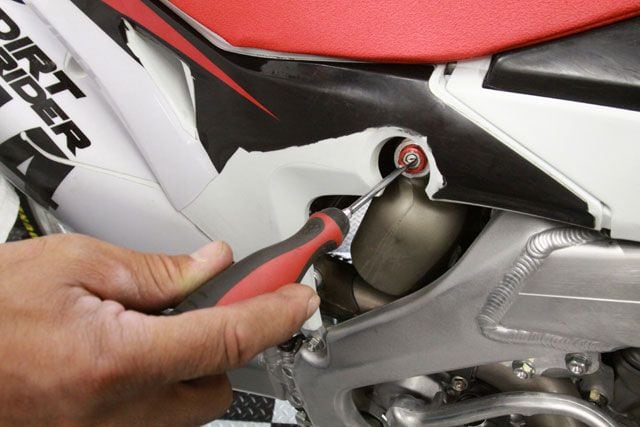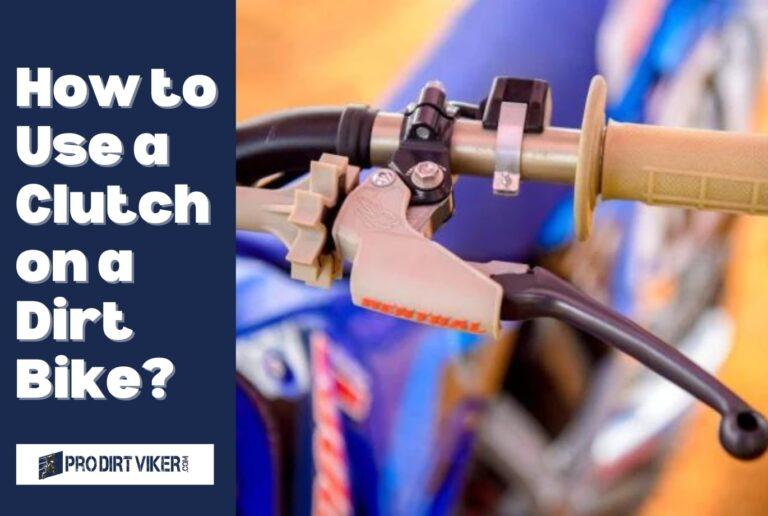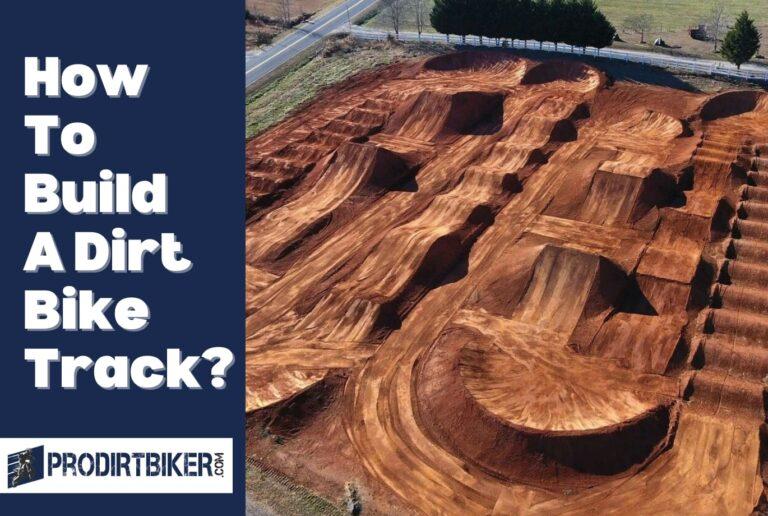How To Easily Adjust Suspension On A Dirt Bike
To adjust suspension on a dirt bike, follow these steps: Firstly, determine your weight and set the sag on the rear shock accordingly. Then, make adjustments to the compression and rebound damping on the front forks to optimize suspension performance.
Welcome to the world of dirt bike suspension adjustment! Whether you’re a seasoned dirt bike rider or a beginner, it’s essential to understand how to adjust your bike’s suspension for optimal performance. Properly adjusting your suspension can improve your bike’s handling, comfort, and overall riding experience.
We will guide you through the process of adjusting the suspension on a dirt bike to help you achieve the best possible ride. By following these simple steps, you’ll be able to tailor your bike’s suspension to suit your weight and riding style, ensuring a smooth and controlled ride on any terrain. So, let’s dive in and learn how to adjust the suspension on a dirt bike!

Credit: www.dirtrider.com
Understanding Suspension Components
Front Suspension Components
The front suspension of a dirt bike consists of several components that work together to provide a smooth and controlled ride. Understanding these components is essential for properly adjusting the suspension. Let’s take a closer look at each one:Forks
The forks are the main part of the front suspension and are responsible for absorbing impacts and maintaining stability. They consist of two telescopic tubes that contain the springs and damping mechanisms. The springs support the weight of the bike and rider, while the damping controls the rate at which the forks compress and rebound.Triple Clamps
The triple clamps, also known as the triple trees, are the components that connect the forks to the frame of the dirt bike. They provide stability and allow the forks to rotate for steering. These clamps also house the handlebars and other essential controls.Springs
Springs play a crucial role in the front suspension system. They support the weight of the bike and rider, ensuring that the bike remains level and balanced. The spring rate determines how stiff or soft the suspension feels. Adjusting the springs can improve the bike’s handling and responsiveness.Rear Suspension Components
In addition to the front suspension, dirt bikes also have rear suspension components that contribute to a smooth and controlled ride. Let’s take a closer look at them:Shock Absorber
The shock absorber, also known as the rear shock or rear suspension unit, is responsible for dampening the bumps and vibrations encountered by the rear wheel. It consists of a spring and a damping system, similar to the front forks. The shock absorber can be adjusted to tailor the suspension to different riding conditions and rider preferences.Linkage
The linkage connects the shock absorber to the frame and swingarm of the dirt bike. It helps to transmit the forces from the rear wheel to the shock absorber and provides leverage for better suspension performance. Proper adjustment of the linkage can greatly affect the bike’s handling and comfort.Swingarm
The swingarm is the rear part of the frame that connects the rear wheel to the rest of the bike. It allows the rear wheel to move up and down while maintaining stability. The swingarm, along with the shock absorber and linkage, plays a vital role in the rear suspension system. Understanding each of these suspension components is crucial for adjusting the suspension on a dirt bike. By making the necessary adjustments to the forks, triple clamps, springs, shock absorber, linkage, and swingarm, riders can optimize their bike’s performance and enjoy a more comfortable and controlled ride.Determining The Correct Suspension Settings
Importance of Proper Suspension Setup
When it comes to riding a dirt bike, one of the most critical factors for optimal performance and rider comfort is the suspension setup. Properly adjusting the suspension can significantly enhance the bike’s handling, stability, and overall control. Whether you’re a professional rider or a weekend enthusiast, understanding how to determine the correct suspension settings is essential.
Rider Weight and Riding Style
When adjusting the suspension on a dirt bike, one of the key considerations is the rider’s weight and riding style. A heavier rider will put more pressure on the suspension, which may require adjusting the sag and compression damping settings. Conversely, a lighter rider may need to make different adjustments to achieve optimal performance. Additionally, considering the rider’s riding style, whether it’s aggressive or more casual, can help determine the ideal suspension settings for a smooth and controlled ride.
Setting Sag
Setting the sag is a crucial step in adjusting the suspension properly. Sag refers to the amount the suspension compresses under the bike’s weight when the rider is sitting on it. There are two types of sag to be aware of: rider sag and static sag.
Rider Sag
Rider sag is the measurement of how much the suspension compresses with the rider’s weight, gear, and riding position applied. It determines the initial response of the suspension when the bike encounters bumps or obstacles. Adjusting the preload on the rear shock or changing the fork spring tension can help achieve the recommended rider sag for optimal performance.
Static Sag
Static sag refers to the compression of the suspension when the bike is completely unweighted. It is the measurement of how much the suspension sags under the bike’s own weight. By adjusting the preload on the forks and shock absorber, you can fine-tune the static sag to match the bike’s specifications. This helps ensure the suspension operates within the proper range and provides optimal control and compliance.
Adjusting Compression Damping
Compression damping controls how quickly the suspension compresses when encountering bumps or impacts. It helps prevent the suspension from bottoming out and provides stability and control. There are two types of compression damping to adjust: high-speed compression and low-speed compression.
High-Speed Compression
High-speed compression damping affects the suspension’s response to large impacts, jumps, or aggressive riding. Increasing the high-speed compression damping can help control bottoming out and provide a more secure feel. On the other hand, decreasing the high-speed compression damping can improve the bike’s ability to absorb smaller bumps and maintain traction.
Low-Speed Compression
Low-speed compression damping influences the suspension’s response to slower, repetitive motions like ruts and small bumps. Adjusting the low-speed compression damping can help find the right balance between comfort and control. Increasing the low-speed compression damping can provide more stability on rough terrain, while decreasing it can enhance the bike’s ability to absorb smaller bumps and maintain traction.
Rebound Adjustment
Rebound adjustment controls how quickly the suspension extends after compressing. It affects the bike’s stability and handling, particularly when encountering jumps or aggressive riding. Fine-tuning the rebound adjustment to match the track conditions and riding style can help improve traction and overall control. Increasing the rebound damping can provide more stability, while decreasing it can enhance the bike’s ability to absorb bumps and maintain traction.
Fine-Tuning for Different Terrains
Depending on the type of terrain you ride on, such as motocross tracks, trails, or sand dunes, you may need to make specific adjustments to the suspension settings. For example, riding on a bumpy track may require increasing the compression damping to handle the rough terrain effectively. Conversely, riding on a softer surface, like sand, may involve decreasing the compression damping for better traction. Experimenting and fine-tuning the suspension settings based on the terrain can lead to a more enjoyable and controlled riding experience.
Step-By-Step Suspension Adjustment Process
Preparation
Before adjusting the suspension on your dirt bike, it’s important to gather the necessary tools and prepare your bike for the process. Here are the steps you need to follow:- Start by finding a flat and level surface to work on.
- Ensure that your bike is clean and free from any dirt or debris that may interfere with the adjustment process.
- Check your bike’s manufacturer manual for specific recommendations on suspension settings.
- Prepare the necessary tools such as a spanner, shock pump, and a measuring tape.
Front Suspension Adjustment
Adjusting Fork Preload
The first step in adjusting the front suspension of your dirt bike is to set the fork preload. The preload determines the initial compression of the fork springs when the bike is at rest. Here’s how you can adjust the fork preload:- Locate the preload adjusters on each fork leg.
- Using a spanner, turn the adjusters clockwise to increase preload or counterclockwise to decrease preload.
- Make small adjustments and test the suspension to find the optimal setting.
Adjusting Fork Compression Damping
Next, you’ll need to adjust the compression damping of the front forks. Compression damping controls how the forks absorb impact and prevent them from bottoming out. Follow these steps to adjust the compression damping:- Locate the compression damping adjusters on each fork leg.
- Rotate the adjusters clockwise to increase compression damping or counterclockwise to decrease compression damping.
- Make incremental adjustments and test the suspension to find the desired compression damping setting.
Adjusting Fork Rebound
The last step in front suspension adjustment is to adjust the rebound damping. Rebound damping controls how quickly the fork springs return to their original position after compression. Here’s how to adjust the rebound damping:- Find the rebound damping adjusters on each fork leg.
- Turn the adjusters clockwise to increase rebound damping or counterclockwise to decrease rebound damping.
- Make small adjustments and test the suspension to achieve the desired rebound damping setting.
Rear Suspension Adjustment
Adjusting Spring Preload
To adjust the rear suspension, you’ll need to start with the spring preload. The spring preload determines the initial compression of the rear shock spring. Follow these steps to adjust the spring preload:- Locate the preload adjuster on the rear shock.
- Use a spanner to turn the adjuster clockwise to increase preload or counterclockwise to decrease preload.
- Test the suspension and make incremental adjustments to find the optimal spring preload setting.
Adjusting Compression Damping
Next, you’ll need to adjust the compression damping of the rear suspension. Compression damping controls how the rear shock absorbs impacts. Here’s how to adjust the compression damping:- Find the compression damping adjuster on the rear shock.
- Rotate the adjuster clockwise to increase compression damping or counterclockwise to decrease compression damping.
- Make small adjustments and test the suspension to achieve the desired compression damping setting.
Adjusting Rebound Damping
The last step in rear suspension adjustment is to adjust the rebound damping. Rebound damping controls how quickly the rear shock spring returns to its original position after compression. Follow these steps to adjust the rebound damping:- Locate the rebound damping adjuster on the rear shock.
- Turn the adjuster clockwise to increase rebound damping or counterclockwise to decrease rebound damping.
- Make small adjustments and test the suspension to achieve the desired rebound damping setting.
Testing and Evaluating the Changes Made
After making the necessary suspension adjustments, it’s important to test and evaluate the changes you’ve made. Take your bike for a ride and pay attention to how it handles different terrains and obstacles. Make notes of any improvements or issues you may encounter.Making Further Adjustments if Necessary
If you find that the suspension is still not performing as desired, you may need to make further adjustments. Refer to your bike’s manufacturer manual for guidance on troubleshooting common suspension issues. Remember to make incremental adjustments and continue testing until you find the optimal suspension settings for your riding style and preferences.Frequently Asked Questions Of How To Adjust Suspension On A Dirt Bike
How Do You Tighten The Rear Suspension On A Dirt Bike?
To tighten the rear suspension on a dirt bike, adjust the sag by turning the preload adjuster in (clockwise) until it reaches its limit. Remember to count the clicks or turns out (counter-clockwise) for reference. This will help improve the bike’s handling and responsiveness.
How Do You Reset The Suspension On A Dirt Bike?
To reset the suspension on a dirt bike, turn it in (clockwise) until it stops, then count the clicks or turns out (counter-clockwise). When the suspension reaches its lower limit and can’t compress any further, you’ll hear and feel it bottom out.
Adjusting the suspension sag is essential for optimal performance.
How Do You Adjust A Fork Rebound On A Dirt Bike?
To adjust the rebound on a dirt bike’s fork, turn the rebound clickers clockwise to increase damping or counterclockwise to decrease damping. Refer to your bike’s manual for the exact number of clicks needed for your desired rebound setting.
How Can I Make My Bike Suspension Smoother?
To make your bike suspension smoother: 1. Set the sag properly to match your weight. 2. Adjust the compression damping to find the right balance. 3. Fine-tune the rebound adjustment for optimal performance. 4. Consider upgrading your bike forks or rear shocks if necessary.
5. Regularly service and maintain your suspension for consistent smoothness.
Q: How Do I Adjust The Suspension On My Dirt Bike?
A: To adjust the suspension on your dirt bike, you’ll need to consider factors such as your weight, sag, and compression damping.
Conclusion
Adjusting the suspension on a dirt bike is a crucial aspect of enhancing your riding experience. By properly setting sag, adjusting the compression and rebound, and considering the rider’s weight and preferences, you can optimize your bike’s performance on different terrains.
Remember, regular maintenance and periodic checks are essential to ensure the suspension remains in good condition. With the right adjustments, you can enjoy a smoother and more controlled ride on your dirt bike.




